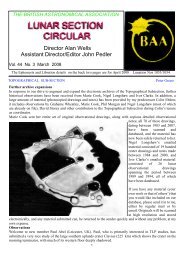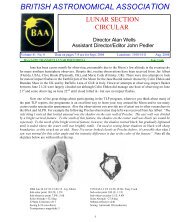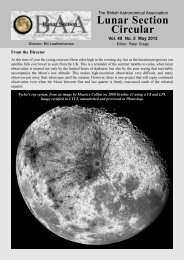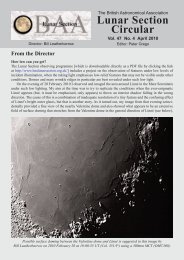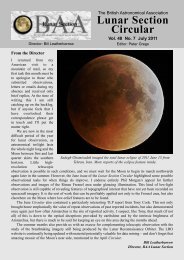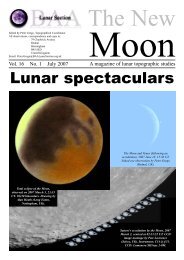A magazine of lunar topographic studies Vol. 17 No. 2 December 2008
A magazine of lunar topographic studies Vol. 17 No. 2 December 2008
A magazine of lunar topographic studies Vol. 17 No. 2 December 2008
- No tags were found...
You also want an ePaper? Increase the reach of your titles
YUMPU automatically turns print PDFs into web optimized ePapers that Google loves.
Hippalus<strong>2008</strong> <strong>December</strong> 720:10 to 20:45 UTCol. 31.6° to 31.9°Moon’s age: 10.1 dLunation 1063Seeing: AII-III, some mist200 mm SCT x200, binoview, integrated lightPDA sketch (north at top), enhanced inPhotoPaint immediately indoorsPeter GregoLocation: St Dennis, Cornwall, UK<strong>No</strong>tes: Hippalus had just begun to emerge fromthe morning terminator. I was intrigued by thenetwork <strong>of</strong> faintly illuminated patches on thefloor, which was mainly in shadow. <strong>No</strong>ne <strong>of</strong> theRimae Hippalus were immediately obviousowing to the shallow illumination and abundance<strong>of</strong> shadow. A broad dark band <strong>of</strong> shadowran from north to south across Hippalus andextended further south, blending into the terminator.Hippalus’ northwestern rim appeared asa bright line. To the southwest, the peaks <strong>of</strong> Promontorium Kelvin jutted out <strong>of</strong> the shadow, alongwith several peaks south <strong>of</strong> Hippalus. Another set <strong>of</strong> illuminated peaks could be seen north <strong>of</strong>Hippalus. A dusky tract where Rima Hippalus II lies was visible to the northeast betweenHippalus’ northeast wall and Agatharchides A, and only part <strong>of</strong> the Rima Hippalus III was visible.Poisson<strong>2008</strong> <strong>No</strong>vember 1901:40 to 02:15 UTCol. 162.7° to 163.0°Moon’s age 21.1 dLunation 1062Seeing: AII, clear skies300 mm Newtonian, x100 x200PDA sketch (north at top)enhanced in PhotoPaintimmediately indoorsPeter GregoLocation: St Dennis, Cornwall<strong>No</strong>tes: The unusual kidneybeanshape <strong>of</strong> Poisson is evidentlyvery ancient and overlainby several smaller craters,namely Poisson A and T in thenorth and west and Poisson U and V in the south. Poisson’s floor, most <strong>of</strong> which was illuminatedby the late afternoon sunshine, appeared somewhat hilly. A sizeable unnamed crater about 50 kmin diameter appeared to lie to the southeast <strong>of</strong> Poisson. Apianus lies just north <strong>of</strong> the area drawn,its southern edge depicted. To the far west is the eastern rim <strong>of</strong> Aliacensis.The New Moon <strong>December</strong> <strong>2008</strong>Page 15



